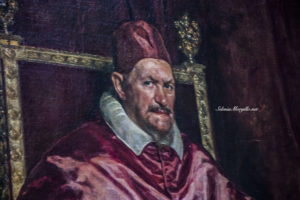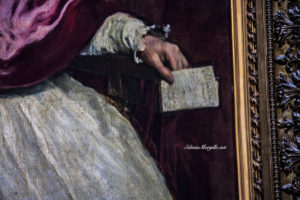Velazquez and Innocenzo X Pamphilj
Italian Version below*
Between 1649 and 1651, during his second stay in Italy, Diego Velazquez, the protagonist of European Naturalism, painted the portrait of Pope Innocent X Pamphilj which is kept in the Gallery of the same name in Rome.
There are numerous legends surrounding the execution of the work.
The painter seems to have been unknown in the eyes of the Pope, although we know with certainty that Innocent X had had the opportunity to get to know the Spanish painter and his skill previously.
The painting became one of the most famous in Rome for being so “real and natural”.
They tell the chronicles that the Pope when he saw for the first time the portrait had exclaimed: “It is too true!”.
Perhaps Velazquez had simply destined the Pope’s true personality for eternity, known for having a not too peaceful, often rough, and direct character.
This “truth” almost frightens, not because Velazquez is a painter who reproduces the work as a photograph, but because it reproduces the darkest and most disturbing aspects of a human personality.
Some details such as the white sheet that the Pope holds in his hand confirm the year of realization, 1650 (jubilee year) or the white dress he wears appears to be linen and directs us towards execution of the work that took place in the summer months.
Velazquez uses only two colors, white and red, and, despite this, manages to create a masterpiece. Synthesis of contrasts and visual tensions: the sacredness of the pose is echoed by the little “hieratic” of the Pope’s expression, almost intolerant of keeping the same position for a long time.
It seems that Innocent had given him only one “pose” session, but also in this case some preparatory drawings suggested that it was another legend.
MAYBE NOT EVERYONE KNOWS THAT …centuries later in 1953 the Irish painter Francis Bacon, so enchanted by this historical portrait, decided to paint Study of the Portrait of Innocent X giving humanity a different version of man’s vulnerability: the Pope he is a normal man, terrified and with his mouth wide open, alone and defenseless.
Where to find it: DoriaPamphilj Gallery
The Doria Pamphilj Gallery is a treasure trove of masterpieces, don’t miss the bust of Olimpia woman made by Alessandro Algardi or the incredible Penitent Magdalene of Caravaggio !!
All rights reserved*
Tra il 1649 ed il 1651, durante il suo secondo soggiorno in Italia, Diego Velazquez protagonista del Naturalismo Europeo, realizza il ritratto di Papa Innocenzo X Pamphilj che è conservato presso la Galleria omonima di Roma.
Numerose sono le leggende che circondano l’esecuzione dell’opera.
Il pittore pare fosse sconosciuto agli occhi del Papa, anche se sappiamo con certezza che Innocenzo X aveva avuto la possibilità di conoscere il pittore spagnolo e la sua maestrìa in precedenza.
Il quadro divenne tra i più celebri di Roma per il suo essere così “reale e naturale”.
Raccontano le cronache che il Papa quando vide per la prima volta il ritratto avesse esclamato : “E’ troppo vero!”.
Forse Velazquez aveva semplicemente destinato all’eternità la vera personalità del Papa, noto per avere un carattere non troppo pacifico, spesso ruvido e diretto.
Questa “verità” quasi spaventa, non perché Velazquez sia un pittore che riproduce come fosse una fotografia l’opera, quanto perché riproduce gli aspetti più tenebrosi ed inquietanti di una personalità umana.
Alcuni dettagli come il foglietto bianco che il Papa regge nella mano confermano l’anno di realizzazione, il 1650 (anno giubilare) oppure il vestito bianco che egli indossa sembra essere di lino e ci indirizza verso un’esecuzione dell’opera avvenuta nei mesi estivi.
Velazquez utilizza solo due colori, il bianco ed il rosso e riesce, nonostante ciò, a realizzare un capolavoro. Sintesi di contrapposizioni e tensioni visive: alla sacralità della posa fa eco la poca “ieraticità” dell’espressione del Papa, quasi insofferente nel tenere a lungo la medesima posizione.
Sembra che Innocenzo gli avesse concesso una sola seduta di “posa”, ma anche in questo caso alcuni disegni preparatori hanno fatto supporre che si trattasse di un’altra leggenda.
FORSE NON TUTTI SANNO CHE….A distanza di secoli nel 1953 il pittore irlandese Francis Bacon, così ammaliato da questo ritratto storico, decide di dipingere Studio del Ritratto di Innocenzo X restituendo all’umanità una versione diversa della vulnerabilità dell’uomo: il Papa è un uomo normale, terrorizzato e con la bocca spalancata, solo e senza difese.
Dove trovarlo: Galleria DoriaPamphilj
La Galleria Doria Pamphilj è uno scrigno di capolavori, non perdete il busto di Donna Olimpia realizzato da Alessandro Algardi o l’incredibile Maddalena Penitente di Caravaggio!!
Sostieni #laculturachevince, aiuta la condivisione.

